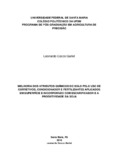| dc.creator | Garlet, Leonardo Cocco | |
| dc.date.accessioned | 2018-07-02T19:31:53Z | |
| dc.date.available | 2018-07-02T19:31:53Z | |
| dc.date.issued | 2018-02-19 | |
| dc.identifier.uri | http://repositorio.ufsm.br/handle/1/13637 | |
| dc.description.abstract | Brazil is the second largest producer of soybeans worldwide, however, the improvement of soil chemistry through liming could raise productivity even more, especially in years of water deficit. In this context, the work had as objective to evaluate the response of the soybean crop under different sources of calcium and magnesium applied on surface and incorporated and its effect on the chemical characteristics of the soil. The experimental design was through randomized blocks with three replications, in commercial area in the city of Julio de Castilhos-RS. The treatments were as follows: control (T0); correction with dolomitic limestone for ½ SMP according with the recommendation of the CQFS RS/SC (2004) (T1); T1 incorporated (T2); 1 SMP (T3); T3 incorporared (T4); correction to balance the bases: Ca 60% Mg 15% e K 3% (T5); T5 incorporated (T6); T5 with addition of 2 Mg ha-1 of agricultural gypsum and T8 with 200kg of calcite. Soil samples were stratified at depths of 0,0-0,10 m, 0,10-0,20 m and 0,20-0,40 m at two sampling times (9 and 21 months). The yields of the soybean crop (two harvests) were evaluated. There was improvement in pH H2O in the surface layer in all treatments, and in the subsurface layer in the second collection, but the treatment 5 in the first collection presented the lowest level of Al+3, and higher relative productivity accumulated. The planned Ca/Mg ratio was not achieved, but there was a chemical improvement in the soil profile with increase in Ca+2 and Mg+2 compared to the control. As for the application method, superficially was economically viable, moreover, the improvement in nutrient contents proved to be more important than the relation between nutrients. | eng |
| dc.language | por | por |
| dc.publisher | Universidade Federal de Santa Maria | por |
| dc.rights | Attribution-NonCommercial-NoDerivatives 4.0 International | * |
| dc.rights.uri | http://creativecommons.org/licenses/by-nc-nd/4.0/ | * |
| dc.subject | Sub superficial | por |
| dc.subject | Acidez | por |
| dc.subject | Calagem | por |
| dc.subject | Subsurface | eng |
| dc.subject | Acidity | eng |
| dc.subject | Liming | eng |
| dc.title | Melhoria dos atributos químicos do solo pelo uso de corretivos, condicionador e fertilizantes aplicados em superfície e incorporado com escarificador e a produtividade da soja | por |
| dc.title.alternative | Improvement of chemical attributes of the soil by the use of corrective, conditioner and fertilizers applied in surface and incorporated with scarifier and the productivity of soybean | eng |
| dc.type | Dissertação | por |
| dc.description.resumo | O Brasil ocupa a segunda colocação na produção mundial de soja, no entanto, a melhoria química do solo, através da calagem poderia elevar ainda mais a produtividade, principalmente em anos de déficit hídrico. Neste contexto, o trabalho teve como objetivo avaliar a resposta da cultura da soja sob diferentes fontes de cálcio e magnésio aplicado em superfície e incorporado e seu efeito nas características químicas do solo. O delineamento experimental foi de blocos ao acaso com três repetições, em área comercial no município de Júlio de Castilhos-RS. Com os seguintes tratamentos: testemunha (T0), correção com calcário dolomítico para ½ SMP de acordo com a recomendação da CQFS RS/SC (2004) (T1), T1 incorporado (T2); 1 SMP (T3); T3 incorporado (T4); correção para equilibrar as bases: Ca 60% Mg 15% e K 3% (T5); T5 incorporado (T6); T5 com adição de 2 Mg ha-1 de gesso agrícola (T7) e T8 com 200 Kg de calsite. As amostras de solo foram estratificadas na profundidade de 0,0-0,10 m, 0,10-0,20 m e 0,20-0,40 m em duas épocas (9 e 21 meses) de amostragem. Foram avaliadas as produtividades da cultura do soja (duas safras). Houve melhoria no pH H2O na camada superficial em todos tratamentos, e na camada subsuperficial na segunda coleta, mas o tratamento 5 na primeira coleta apresentou o menor nível de Al+3, e maior produtividade relativa acumulada. Não se conseguiu a relação de Ca/Mg planejada, porém houve melhoria química no perfil do solo com aumento nos teores de Ca+2 e Mg+2 comparado com a testemunha. Quanto ao modo de aplicação, superficialmente foi economicamente viável que a incorporação, além disso, a melhoria nos teores dos nutrientes mostrou-se mais importante do que a relação entre os nutrientes. | por |
| dc.contributor.advisor1 | Amado, Telmo Jorge Carneiro | |
| dc.contributor.advisor1Lattes | http://lattes.cnpq.br/8591926237097756 | por |
| dc.contributor.referee1 | Fiorin, Jackson Ernani | |
| dc.contributor.referee1Lattes | http://lattes.cnpq.br/6845721050199588 | por |
| dc.contributor.referee2 | Reimche, Geovane Boschmann | |
| dc.contributor.referee2Lattes | http://lattes.cnpq.br/8140181961367166 | por |
| dc.creator.Lattes | http://lattes.cnpq.br/3907401161651509 | por |
| dc.publisher.country | Brasil | por |
| dc.publisher.department | Tecnologia em Agricultura de Precisão | por |
| dc.publisher.initials | UFSM | por |
| dc.publisher.program | Programa de Pós-Graduação em Agricultura de Precisão | por |
| dc.subject.cnpq | CNPQ::CIENCIAS AGRARIAS::AGRONOMIA | por |
| dc.publisher.unidade | Colégio Politécnico da UFSM | por |



